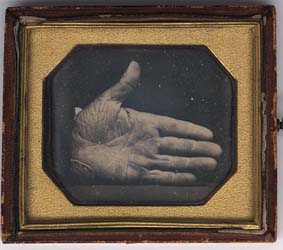The branded hand of Captain Jonathan Walker
To order an image, navigate to the full
display and click "request this image"
on the blue toolbar.
This photograph shows the hand of Captain Jonathan W. Walker, an ardent abolitionist. His hand was branded with the letters, "S.S.," for slave stealer, after he was convicted and sentenced for attempting to assist seven escaped slaves to freedom by sailing them from Florida to the West Indies in 1844.
What is a daguerreotype?
In January of 1839, painter Louis Jacques Mandé Daguerre lectured at the French Academy of Sciences in Paris on his new discovery: a technique for recording a camera image on a silver-plated sheet of copper. Daguerre called his invention the "daguerreotype," and scientists and artists alike were astonished by the sharp, clear photographic images. Daguerre's process involved polishing and chemically cleaning a silver-plate copper sheet, then sensitizing the silver side by laying it down over a box of iodine particles. The fumes from the particles reacted with the silver to form a light-sensitive silver iodide. After exposing the sensitive sheet in a camera and placing it in contact with a heated mercury solution, the image became visible. The copper plate was then bathed with a strong sodium chloride solution that rendered the plate insensitive to further light action.
The Massachusetts Historical Society has a collection of over 450 daguerreotypes, most of which are portraits that have come to the MHS individually or as part of collections of personal and family papers.
To locate individual daguerreotypes, please search ABIGAIL, our online catalog for "daguerreotypes."

